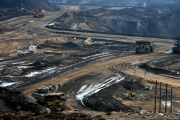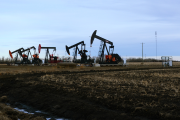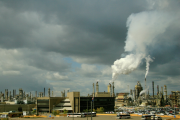Over the last few months, debates about pipelines have become a staple of the news in Canada. Indeed, pipelines have become the main pretext for our conversations about climate change and the impacts of oilsands development — at least when Neil Young doesn’t happen to be in town.
As a result, many Canadians have come to know the starting lineup of the pipeline expansion team, from Keystone XL and Northern Gateway to Trans Mountain and Line 9, very well.
In 2014, we can expect to hear a lot more about the biggest new prospect of them all, a 4,400-kilometre-long project called Energy East.
Proposed by TransCanada, the same company that’s behind Keystone XL, Energy East would carry over one million barrels of crude per day from central Alberta to New Brunswick. Ontario Energy Minister Bob Chiarelli has called the $12-billion proposal “the largest pipeline project in Canada in over 50 years.” Anything that big carries significant opportunities, risks and consequences.
The Pembina Institute recently published an initial assessment of one of the pipeline's consequences: its potential contribution to climate change. We calculated how much carbon pollution would be generated by filling the pipeline with a mix of Alberta oilsands and Canadian conventional crude. The result was between 30 and 32 million tonnes of carbon pollution each year.
That’s equivalent to the carbon pollution produced by seven million cars — roughly the number of cars on the road in Ontario today. It’s more than the current emissions of five separate provinces.
Or think of it this way: Canada’s single most effective climate policy by far is Ontario’s phase-out of coal power. It’s projected to cut Canada’s emissions in 2020 by 32 million tonnes. If Energy East goes ahead, the emissions associated with the pipeline could wipe out the gains made by Ontario’s policy.
It’s worth acknowledging that not everyone thinks that pipelines lead to new carbon pollution. Some argue that the oilsands will be developed no matter what, so building a new pipeline has no impact on the pace of oilsands development.
We’re not convinced. Energy East would increase the capacity of the pipeline network that carries crude out of western Canada by one-third. Crucially, this pipeline would carry oilsands to tidewater, where companies can load their crude onto tankers and sell it wherever in the world it fetches the best price.
Opening up the oilsands to world markets would make the economics of building a new project much more compelling. That, in turn, leads to new oilsands production and the carbon pollution that comes with it.
TransCanada plans to file its application for Energy East in the first half of this year. In the months ahead, governments will have to decide how to assess the project and its impact.
Here’s what we recommend: any review of the Energy East proposal should consider not just the impact of the pipeline itself, but also the impact of the product that flows through it.
That may sound like common sense, and it is. But the most recent Canadian precedent — the National Energy Board’s review of the Northern Gateway proposal — took a far more limited view. Although many Canadians asked for a more complete assessment, the panel restricted its review of environmental impacts to the pipeline infrastructure itself.
In the U.S., it’s a different story. President Barack Obama has committed to make his decision on TransCanada’s Keystone XL pipeline project based on its impact on the climate. That puts oilsands emissions at the heart of that project’s regulatory review.
Our report shows that Energy East would have an even bigger climate impact than Keystone XL. Surely Canadians also deserve a review that considers the full picture of a proposed pipeline’s impacts.
Oilsands companies have pointed out that governments already look at greenhouse gas emissions when they review individual projects, so they don’t see the need to include oilsands emissions in pipeline reviews as well.
Unfortunately, the current review system isn’t working for carbon pollution. Alberta’s consideration of climate impacts at the project level is weak, while the federal government has opted out of reviewing a growing number of oilsands projects altogether. Meanwhile, thanks largely to the projected rapid growth in oilsands emissions, neither government is on track to meet its 2020 climate target.
We need a venue for a meaningful discussion about the impacts — both positive and negative — of growing oilsands production. Indeed, TransCanada has already commissioned analysis of Energy East’s impacts that extends well beyond the pipeline route. An economic modelling study prepared by Deloitte discusses the benefits of Energy East for oilsands producers, refiners and consumers — all groups that are located either “upstream” or “downstream” of the proposed pipeline.
If it’s valid to take a broader perspective when we’re talking about the economics of pipelines, then surely it’s appropriate to do the same when we’re talking about the environment. Canadians deserve the full picture before we make a decision.
Clare Demerse is the federal policy director at the Pembina Institute, a national clean energy think tank.






